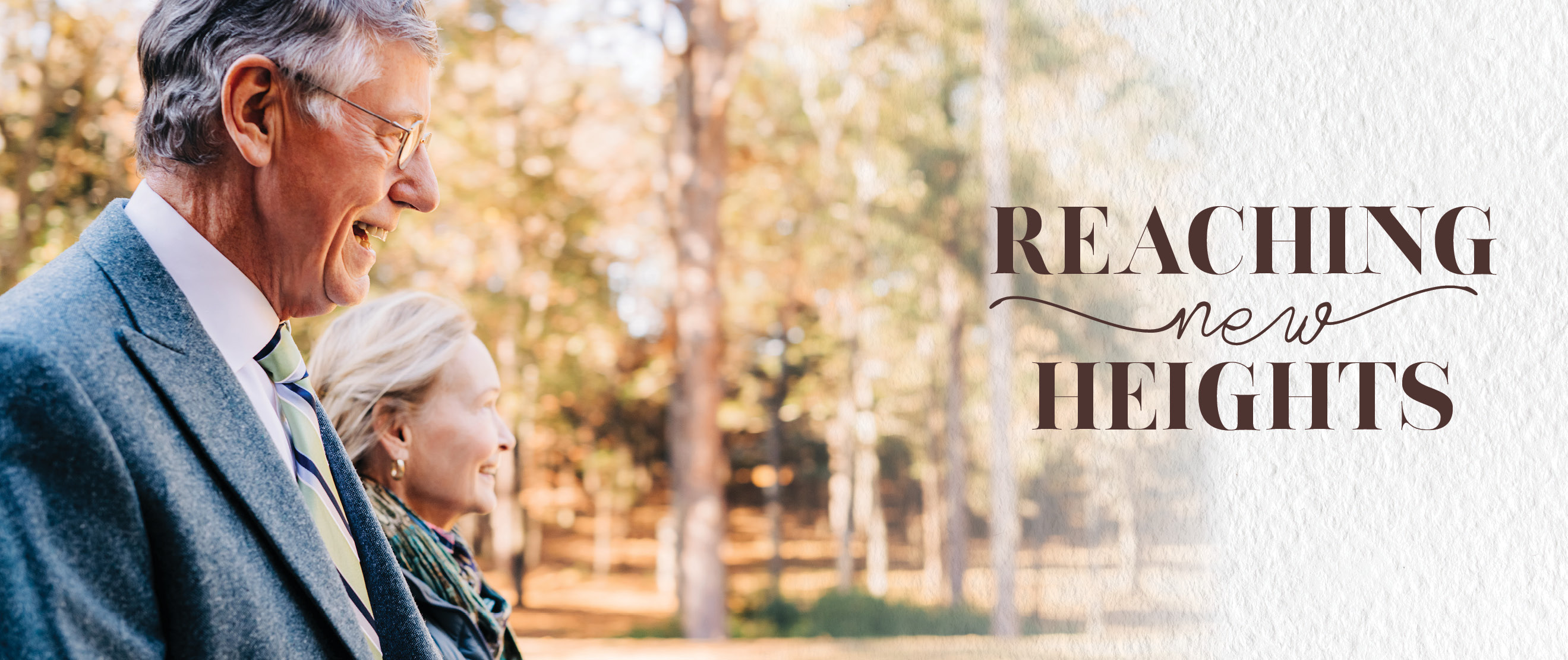In September, the School of Medicine embarked on what promises to be an unprecedented era of growth thanks to a transformational $95 million lead gift from longtime University of Alabama at Birmingham (UAB) supporter Marnix E. Heersink, M.D., which was enhanced with a contribution of $5 million from Triton Health Systems. In recognition of this singular act of philanthropy, the school has been renamed the UAB Marnix E. Heersink School of Medicine. Along with a new name, the gift bestows a host of new opportunities and avenues of exploration, with implications for metamorphic change not just for the school but also for the city of Birmingham and the state of Alabama.
The gift’s impact will be felt across the school, accelerating and expanding our patient care, medical training, and research and innovation enterprises, especially in focus areas such as precision medicine and pharmacogenomics, cancer biology, neurosciences, health disparities, and immunology, among others. The largest portion of the gift will be used to support priority initiatives and recruitment and retention of faculty leaders in the Heersink School of Medicine. The remainder of the gift has established two new institutes in areas of passionate interest for both the school and the Heersink family: the Marnix E. Heersink Institute for Biomedical Innovation and the Mary Heersink Institute for Global Health. The gift will also establish the Marnix E. Heersink Institute for Biomedical Innovation Endowed Support Fund and name the Heersink Biomedical Innovation Conference Center.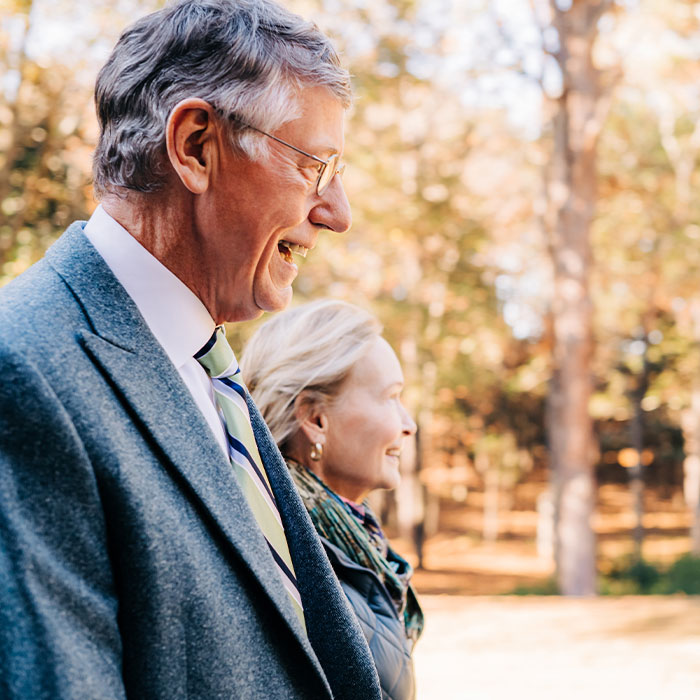 Marnix E. Heersink, M.D., and Mary Heersink, longtime supporters of UAB and the School of Medicine, have made a $95 million gift to name the UAB Marnix E. Heersink School of Medicine, as well as establish two new institutes.
Marnix E. Heersink, M.D., and Mary Heersink, longtime supporters of UAB and the School of Medicine, have made a $95 million gift to name the UAB Marnix E. Heersink School of Medicine, as well as establish two new institutes.
“This historic gift reflects both Dr. Heersink’s heart for service and the scale of our shared ambition for the School of Medicine to be a global leader in biomedical discovery and innovation, medical training, and patient care,” says Selwyn Vickers, M.D., FACS, dean of the UAB Heersink School of Medicine and CEO of the UAB Health System and CEO of the UAB/Ascension St. Vincent’s Alliance. “It is a powerful affirmation of the unlimited potential of our school and reinforces what we have always known: that UAB truly is a world-class institution.”
The Road to Naming
It’s an elite league with names familiar to people inside and outside the medical field: Pritzker, Weill, Perelman, Feinberg, Geffen—all philanthropist-named medical schools, among them some of the most prestigious in the U.S. The Heersink gift is not only the largest in the university’s history, it is among the top 200 private gifts made to higher education since 2017, according to The Chronicle of Higher Education.
The gift came about through a combination of intention and synchronicity. Several years ago, the Dean’s Leadership Team created a strategic plan outlining the school’s ideal growth and the tactics to achieve such growth, including naming the school. “In a short amount of time, just three years, we were able to reach our goal,” says Anupam Agarwal, M.D., executive vice dean in the Heersink School of Medicine. “It was part of our strategy for growth.”
From the beginning, it was important to school leaders to build ethics and values into the strategy of securing a philanthropic gift to name the school. Finding the right donor was key. “Dr. Vickers wanted to seek out a donor aligned with our school’s vision and goals—someone who knew the unique issues of health care, health equity, and barriers in the state of Alabama,” Agarwal explains.
They found that sought-after alignment in Marnix Heersink, M.D., his wife Mary, and their family. The Heersinks are well-known philanthropists in Alabama and beyond, having made significant gifts from their personal funds and through their family foundation. Previous gifts and pledges to UAB include those to renovate the atrium and establish the Heersink Family Active Learning Resource Center in the School of Medicine’s Volker Hall, the Heersink Family Endowed Glaucoma Fellowship, and the Heersink Family Foundation Scholarship Endowment in Optometry, among others.
For their part, the Heersinks made a strategic decision to invest in a medical school with a record of excellence and an upward trajectory of success, criteria the School of Medicine more than meets. The school has experienced remarkable growth under Vickers’ leadership, notably in research funding. In 2018, UAB became part of an elite group of eight academic medical centers that had attained more than $100 million in net NIH funding growth over the previous five years and was the only school to rise 10 spots in five years. According to preliminary data, in 2021 the school ranked No. 21 in NIH research funding with $272 million, placing us on the cusp of achieving our goal of a top 20 NIH ranking.
Marnix Heersink says his confidence in the school’s leadership partly inspired the gift. “The leadership at UAB is respected across the nation,” says Marnix Heersink. “People are aware of Dr. Vickers and the team that he’s recruited. I see this gift as an opportunity to endorse that leadership and watch what happens. It’s an investment that I know will be put to good use.
“I use the acronym GIVE: Gratitude is the first letter—our family was educated here and received health care here, and we’re very grateful for that. The I is for investment—I do believe this gift is an investment in a school that is rising and is only going to get better. And then there’s Values and Vision—the school’s values and vision align perfectly with our family, and I truly believe in what the school stands for. And the last word is Excellence—I believe the things that are being done here exemplify excellence, and I think the whole state should be proud of that. So those four letters are the reason the gift was given.”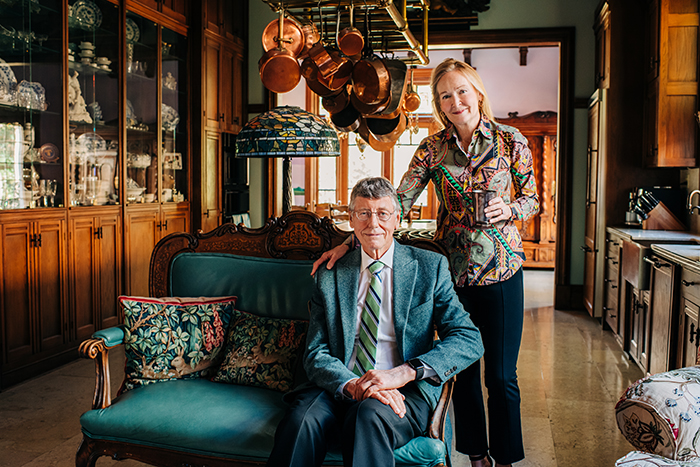 The Heersinks arrived in Dothan, Alabama, in 1978 with, as Dr. Heersink says, “a used car, some clothes, and a lot of love and hope. And great educations.”
The Heersinks arrived in Dothan, Alabama, in 1978 with, as Dr. Heersink says, “a used car, some clothes, and a lot of love and hope. And great educations.”
A Family Dedicated to Service
The denizens of Dothan, Alabama, are long familiar with the Heersink family. “Mary and I came to Dothan in 1978,” says Marnix Heersink, a renowned eye surgeon, innovator, and entrepreneur. “We had in our possession a used car, some clothes, and a lot of love and hope. And great educations.”
The Heersinks’ journey to Alabama started in Europe. Marnix Heersink was born in The Netherlands, where his father was a civil servant who served as mayor of the family’s hometown. The family immigrated to Canada, where his father’s counsel helped guide Marnix toward a career in medicine. “My dad was a very wise man, and when I was about 16 he sat me down and said, ‘What do you want to become?,” Marnix recalls. “I didn’t really know, so he said, ‘Okay, tell me what you don’t want to be.’ We talked and he said, ‘It sounds like you want to be able to do things for other people.’ We checked down a list of possibilities and I realized I needed to keep medicine in the forefront of my mind. That was probably the start of me thinking about a career in health care.”
Marnix Heersink earned a medical degree from the University of Western Ontario in Canada. He completed an internship at the Royal Victoria Hospital in Montreal and an ophthalmology residency at Wills Eye Hospital in Philadelphia, followed by a fellowship in cataract surgery and intraocular lens implantation.
It was during his training in Philadelphia that Marnix met and married Mary Parks, the daughter of renowned pediatric ophthalmologist Marshall Parks, M.D., considered the “father of pediatric ophthalmology.” Parks inspired a reverence for medicine in his children. “In my household growing up, I saw that there was very little division between our family life and his profession,” Mary Heersink says. “His office was attached to our house, so on a typical Sunday afternoon there would be a child knocking on the door because he had an eye injury. Patients were in and out of our home, and teachers and fellows from all over the world visited us. So I grew up with the idea of medicine being an all-encompassing, sacred trust.”
When Marnix completed his training, he and Mary set off to find a location to establish his practice. Dothan was one of several places they visited and they say they immediately felt welcome in the community. In fact, on their first visit to the city, the couple bid on a house they say they knew would be their future home before ever setting foot inside.
Within two years of their arrival in Dothan, Marnix Heersink co-founded Eye Center South with John Fortin, M.D., which in the decades since has grown to 12 locations across Alabama, Georgia, and Florida. In 2019, Marnix Heersink and his family opened Health Center South, a 140,000-square-foot, state-of-the-art medical complex for doctors of all specialties in Dothan. He is also an owner or agent of many other companies, including real estate holdings and manufacturing entities in the United States and abroad.
Since 2017, Mary Heersink has been an invaluable source of counsel as a member of the School of Medicine’s Board of Visitors. She is an internationally known food safety advocate and the author of “E. Coli O157: The True Story of a Mother’s Battle with a Killer Microbe.” In it, she recounts the harrowing experience of her then 11-year-old son Damion, who nearly died from E. coli in the early 1990s. She was inspired to co-found STOP Foodborne Illness, a national grassroots organization dedicated to preventing illness and death from foodborne pathogens. STOP is widely credited as being the driving force behind the passage of the Food Safety Modernization Act of 2011. She is a member of the Advisory Board of the Master of Global Health Program, a joint initiative among McMaster University in Canada, Maastricht University in the Netherlands, Manipal University in India, and Thomassat University in Thailand. She has also served on boards of directors for numerous nonprofit and civic organizations in the Dothan area, including Girls Clubs of Dothan, the Wiregrass Museum of Art, and Landmark Park.
The Heersinks’ commitment to service is perhaps best expressed through their six children, all of whom have pursued careers in health care: ophthalmologists Mila, a Heersink School of Medicine graduate, and Sebastian, an MIT and Georgetown Medical School graduate; Bayne, a dentist who graduated from the UAB School of Dentistry, including a two-year UAB prosthodontic fellowship; Damion, a licensed U.S. patent attorney who earned a Master of Public Health degree from UAB in 2005 and has since earned his medical degree and is now training to become an internal medicine physician at Ochsner Health in New Orleans; and twins Christiaan and Marius, who followed the example set by Mila by participating in UAB’s Early Medical School Acceptance Program and who earned combined M.D./MBA degrees from UAB and are currently in ophthalmology and family medicine residencies, respectively. The Heersinks’ daughter-in-law Juanita Titrud Heersink, M.D., was Ms. UAB in 2003, graduated from the School of Medicine, and completed her internal medicine residency at UAB.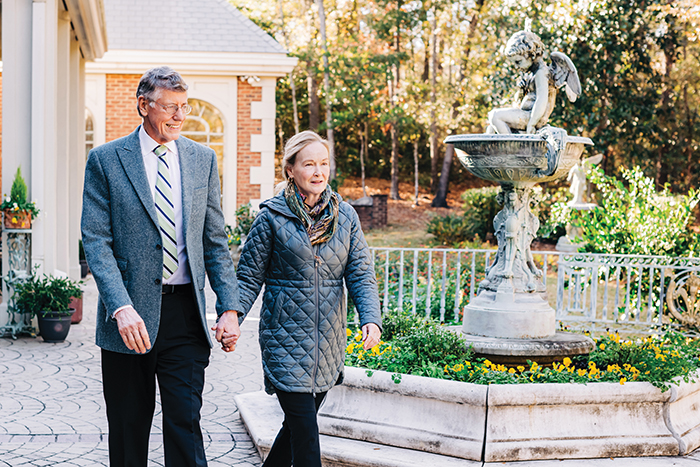 The Heersinks' gift established two new institutes in the school: the Marnix E. Heersink Institute for Biomedical Innovation and the Mary Heersink Institute for Global Health.
The Heersinks' gift established two new institutes in the school: the Marnix E. Heersink Institute for Biomedical Innovation and the Mary Heersink Institute for Global Health.
An Era of New Promise
What is the gift’s significance for the school’s research, patient care, and medical education missions, and how will it impact the school’s future? A large portion of the gift will be used to establish endowments, which are critical for fostering excellence across all our mission areas. That’s because endowments aren’t just about prestige—they are about people, enabling the School of Medicine to recruit and retain the most talented faculty and expanding the possibilities of what we can achieve.
“A combination of new endowed chairs and endowed professorships offers a tremendous opportunity for us in terms of recruitment of new faculty as well as retention of some of our outstanding faculty,” says Tika Benveniste, Ph.D., senior vice dean for Research. “The gift helps us be more competitive with our peer institutions because we can offer protected time for specific research. In addition, these endowments will live at a school-level, so no matter which department a faculty member is appointed to they can be nominated.”
In the clinical care realm, endowed positions increase our capacity to provide innovative patient care, so people don’t feel the need to travel outside the state for specialized treatment. And of course, talented faculty enrich the learning experience immeasurably for medical students and residents, becoming trusted and influential mentors and helping mold trainees into tomorrow’s leading physicians and scientists.
As Agarwal points out, the core of all these enterprises is the same: the patient. “Why are we doing research? To impact and improve patient care. Why do we focus on clinical practice? To treat patients better. Why do we train and educate? To build on research, while training the future generation to treat patients. This gift will benefit all three areas.”
Likewise, the two newly established institutes will increase our capacity and strengthen our efforts in two key focus areas, with benefits that will echo across all mission areas. Led by Alan Tita, M.D., Ph.D., associate dean for Global and Women’s Health in the Heersink School of Medicine, the Mary Heersink Institute for Global Health seeks to improve overall health and well-being and promote equity in health outcomes among people around the world. The institute is building a coordinated, comprehensive, and sustainable infrastructure for the Heersink School of Medicine, UAB, and international partners to help foster educational opportunities, facilitate high-quality biomedical research, and provide services and capacity-building support—all geared toward addressing the most pressing and complex global health challenges.
Tita says the COVID-19 pandemic illustrates perfectly why the time is ripe for the institute. “The pandemic has shown us how interconnected the world really is, and that what happens elsewhere in the world impacts our health here at home. The world is becoming smaller—with faster travel and digital technology and new innovations, we interact and connect with the rest of the world on day-by-day, minute-by-minute basis, so being engaged in global health is in our interest.”
Despite that interconnectivity, disparities in health and health care access—both within the U.S. and across the globe—are glaring. Tita says having robust global health programs will better equip UAB to improve the health of vulnerable populations here at home as well as internationally. “For example, cardiovascular disease is a major cause of death here in Alabama, and is also a major cause of death in many other, less developed countries,” he says. “If we can coordinate across these countries and act together, we bring more to the table to overcome our common challenges.”
Similarly, the Marnix E. Heersink Institute for Biomedical Innovation, led by Rubin Pillay, M.D., Ph.D., assistant dean for Global Health Innovation in the Heersink School of Medicine and chief innovation officer of the UAB Health System, is establishing a framework for what Pillay calls “sustainable innovation” in health care delivery. Innovation involves the spark of creativity and ingenuity, he says, but to make it sustainable you need intention, infrastructure, and support, and that’s where the institute comes in.
“The health care sector in the United States is plagued with sky-high costs, unequal access, and erratic quality,” Pillay says. “The purpose of the institute is to put together a team that is focused on transforming and innovating health care delivery and addressing the quadruple burden of health care cost, quality, access, and experience.”
An important element of the institute will be The Clinic at UAB. “This is the equivalent of an innovation center, where a lot of the applied activities are going to take place,” says Pillay. “Physicians, nurses, staff who have ideas and solutions they’d like to explore can come to the Clinic, and we will help navigate the process and provide the necessary support. And within the clinic we’ll have boot camps and training initiatives.” A satellite location, The Clinic at Dothan, will extend the institute’s mission to rural Alabama.
Education and training will also be a major objective of the institute. “Innovation requires a skill set. We are going to launch a master’s degree in health care innovation, which we believe will be the first master’s in health care innovation delivered by a medical school globally. We will also launch a series of graduate certificates, in AI (artificial intelligence) in medicine, digital health care, and health care innovation.”
Innovation even impacts how the institute plans to deliver its programs and services. “We want to be essentially the first academic program delivered in the metaverse,” Pillay says. “We are going to use a combination of mixed and augmented reality, which will give students, whether they are in Dothan or Mumbai, the same immersive experience that our students in Birmingham get.”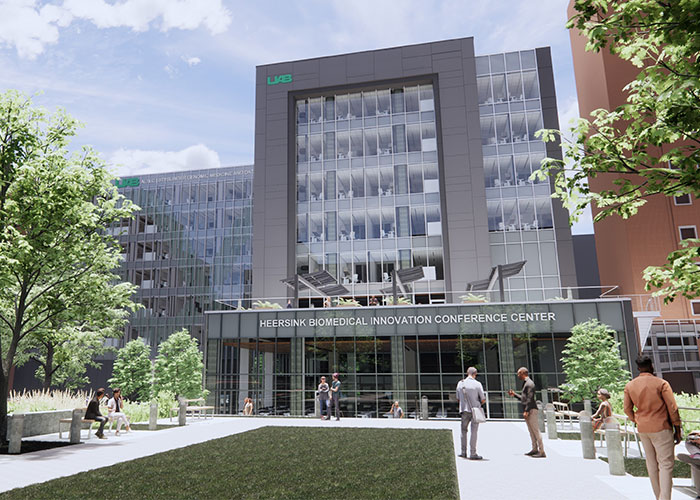 In addition to naming the school and creating two new institutes, the Heersink gift also named the Marnix E. Heersink Institute for Biomedical Innovation Conference Center.
In addition to naming the school and creating two new institutes, the Heersink gift also named the Marnix E. Heersink Institute for Biomedical Innovation Conference Center.
The Road Ahead
While the school’s name may have changed, the qualities that make it worthy of this powerful philanthropic endorsement remain the same: the focus on collaboration and innovation; the ability to respond to the needs of the community; the audacity to dream big dreams and do big things; and above all, the focus on delivering world-class, patient-centered care.
School leaders say the gift will have a domino effect on our surrounding community and the state at large. While the gift will directly strengthen and augment the school’s strategic goals across our mission areas, “it is also going to be a driver for the economic engine of UAB—and by extension Birmingham and the entire state of Alabama,” says Benveniste.
That is just what Marnix Heersink hopes the gift will achieve. “We hope the spinoff from the gift will be of benefit to people who aren’t even at the university—people across the city and state,” he says. “I hope the whole state will be lifted up by what happens here.” – By Jane Longshore and Mary Ashley Canevaro
